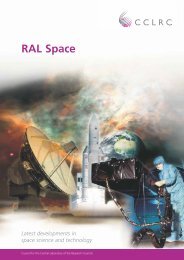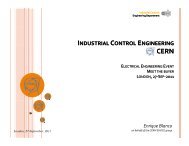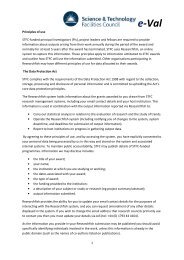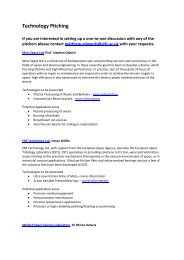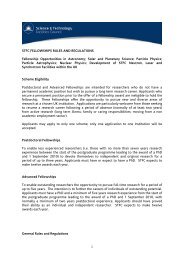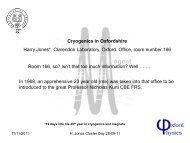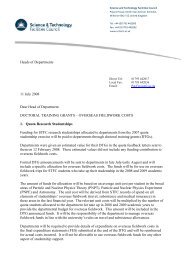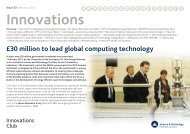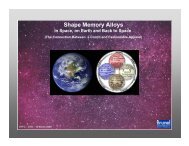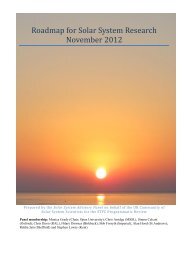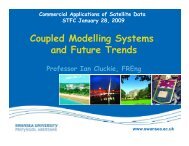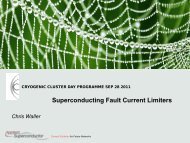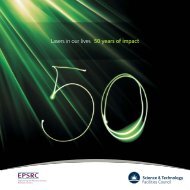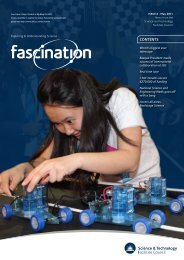Fascination - Science & Technology Facilities Council
Fascination - Science & Technology Facilities Council
Fascination - Science & Technology Facilities Council
Create successful ePaper yourself
Turn your PDF publications into a flip-book with our unique Google optimized e-Paper software.
Image from the ISIS art exhibition, see inside for more details<br />
ISSUE 4 - December 2010<br />
News from the<br />
<strong>Science</strong> and <strong>Technology</strong><br />
<strong>Facilities</strong> <strong>Council</strong><br />
Exploring & Understanding <strong>Science</strong><br />
CONTENTS<br />
Cheaper oil extraction<br />
Taking a closer look<br />
at the eye<br />
Computational <strong>Science</strong><br />
takes on global<br />
challenges<br />
Space Weather<br />
Europe’s First Free<br />
Electron Laser<br />
Diamond illuminates<br />
HIV<br />
Daresbury Joint<br />
Venture Approved<br />
QM2 measures sea<br />
temperature
Greener, cheaper oil extraction<br />
Geographical and geological concerns are not the only<br />
factors that make locating and securing energy supplies such<br />
a challenge. It is an unfortunate fact of life that some of the<br />
places which hold the biggest reserves of energy are also<br />
among the most politically and socially volatile places on Earth.<br />
Not only do companies need to use more innovative techniques,<br />
they also need to consider the longer term effects on the<br />
environment. Reserves that would have been inaccessible a<br />
decade ago are now within reach. Companies and academics are<br />
constantly looking for ways to improve their operations to be able<br />
to continue to meet the world’s energy needs.<br />
A research team led by the University of Bristol has used<br />
STFC’s ISIS neutron source to come up with a new way to treat<br />
carbon dioxide (CO 2<br />
), so that it can be used in efficient and<br />
environmentally friendly methods for extracting oil.<br />
The researchers have developed a soap-like additive for CO 2<br />
that turns it into a viable solvent for commercial-scale enhanced<br />
oil recovery to increase the amount of crude oil that can be<br />
extracted from oil fields.<br />
Liquid CO 2<br />
is increasingly used industrially to replace common<br />
petrochemical solvents because it requires less processing and<br />
it can be easily recycled. The difficulty has been that to operate<br />
effectively as a solvent CO 2<br />
needs additives, many of which are, in<br />
themselves, damaging to the environment. This new development<br />
could be the answer.<br />
CO 2<br />
offers an efficient, cheap, non-toxic, non-flammable<br />
and environmentally responsible alternative to conventional<br />
petrochemical solvents. For example, even water as a solvent<br />
comes with its own set of problems; after being used to flush<br />
out oil from rocks it then requires cleaning before it can be used<br />
again, whereas liquid CO 2<br />
can be re-used immediately.<br />
The results of this work have been published in the journal<br />
Langmuir. The paper is the first to come from Sans2d, one of<br />
seven new neutron instruments at the ISIS second target station, a<br />
£145 million expansion to the facility. It is also one of the first to<br />
be published using data collected at the new target station.<br />
The new additive, surfactant TC14, enables small pockets<br />
to form in the liquid CO 2<br />
. Called ‘reverse micelles’ these cause<br />
the liquid to thicken. Neutron scattering at ISIS allowed the<br />
structure of the ‘reverse micelles’ to be studied in the CO 2<br />
as<br />
they formed under high pressure. The neutron instruments giving<br />
this molecular level viewpoint are often described as ‘supermicroscopes’.<br />
The international team includes scientists from Bristol<br />
University led by Professor Julian Eastoe, the University of<br />
Pittsburgh led by Professor Bob Enick and ISIS scientists Dr Sarah<br />
Rogers and Dr Richard Heenan. The project has been funded by<br />
the UK Engineering and Physical <strong>Science</strong>s Research <strong>Council</strong> and<br />
the US Department of Energy.
ALMA Front End Integration Centre<br />
Ready to Start Production Phase<br />
STFC is participating in the construction of the Atacama Large<br />
Millimeter Array (ALMA), located in the Atacama Desert of the<br />
Northern Chilean Andes.<br />
The project will involve the installation of fifty-four 12m diameter<br />
and twelve 7m diameter telescopes working together as one large<br />
telescope. The site was chosen because of its exceptionally dry<br />
and clear skies, which are required to operate telescopes working<br />
at millimetre and sub-millimetre wavelengths. The quality of the<br />
observing site, combined with unprecedented spectral resolution<br />
and image accuracy made possible with ALMA, will enable<br />
astronomers to carry out transformational research in a wide<br />
variety of astronomical areas, including studying the earliest and<br />
most distant galaxies and probing dust-obscured regions which<br />
are the birthplace of stars and planets.<br />
Key parts of the ALMA project are the ‘Front Ends’, one of<br />
which is needed for each of the 66 antenna. These have up<br />
to ten cryogenically cooled detectors that receive the faint<br />
radio signals emanating from space and convert them into a<br />
frequency range that can be more easily processed. The three<br />
Front End Integration Centres (FEIC) responsible for assembly and<br />
integration of these units are located in North America, Taiwan<br />
and Europe. The European FEIC, which is funded by the European<br />
Southern Observatory, is located within STFC’s RAL Space and has<br />
recently completed the second stage of its operational readiness<br />
review. This review focussed on the test equipment used to<br />
measure some of the key performance requirements of the Front<br />
Ends, such as noise temperature and beam pattern.<br />
At the end of the two day review, the panel declared that the<br />
centre had not only passed, but that they were very impressed<br />
with the high standard of the EU FEIC test equipment. This<br />
validation enables the team to continue with its production phase<br />
with the aim of delivering one Front End to the site each month<br />
for the next two years, meeting its target of 26 by the end of<br />
December 2012, when the array will become fully operational.<br />
The Atacama Large Millimeter Array (ALMA)
Taking a closer look<br />
Particle physics requires more sensitive, tough and smaller detectors<br />
than other applications, forcing engineering breakthroughs which can<br />
be used in other situations.<br />
The largest of the detectors at the LHC, ATLAS will help lead<br />
the search for the Higgs particle, which is believed to provide<br />
all other particles with mass. At the same time as they<br />
pursue these fundamental developments, ATLAS scientists<br />
are taking the knowledge they have gained in their work and<br />
applying it in other fields.<br />
One such example is the subject of a recent paper<br />
in Nature –‘Functional connectivity in the retina at the<br />
resolution of photoreceptors’. A collaboration of scientists<br />
has used a retinal read-out device inspired by technologies<br />
that physicists developed for the ATLAS detector.<br />
Just as an eye converts light and passes the information to<br />
the brain a silicon detector converts light into an electrical<br />
signal that is passed to a read-out system.<br />
The pixel detector of the eye is the retina, which lines the<br />
back of the eye and contains the cells that respond to light.<br />
These specialised cells are called photoreceptors. There are<br />
two types of photoreceptors in the retina: rods and cones.<br />
The rods are most sensitive to light and dark changes and<br />
contain only one type of light-sensitive pigment. The cones<br />
are less sensitive to light but more sensitive to one of three<br />
different colours (green, red or blue) . Signals from the cones<br />
are sent to the brain which then translates these messages<br />
into the perception of colour. Colour vision requires neural<br />
circuitry to compare signals from spectrally distinct cone<br />
types. How these signals are combined and transmitted by<br />
the ganglion cells to the brain has been subject to debate.<br />
This new system records neural signals at high speed with<br />
fine spatial detail, sufficient to detect even a locally complete<br />
population of the tiny and densely spaced output cells<br />
known as ‘midget’ retinal ganglion cells. The high-resolution<br />
recording allowed the researchers to conclude which cone<br />
fed information to which retinal ganglion cell and so trace<br />
for the first time the neural circuitry that connects individual<br />
photoreceptors with retinal ganglion cells.<br />
This research is essential in order to understand how the<br />
retina works and develop potential new therapies for eye<br />
disorders and to possibly even create future retinal prosthetic<br />
devices.<br />
The work is the result of a collaboration including the<br />
University of Glasgow, the Salk Institute for Biological<br />
Studies, UC Santa Cruz and AGH Krakow.
Spinout success<br />
Microvisk Technologies, a spinout company from STFC, is<br />
developing the world’s first medical diagnostic strip based on<br />
a Micro-Electro-Mechanical System (MEMS) that was originally<br />
created as a movement system for nano-robots. MEMS technology<br />
is used in devices such as the i-phone and Nintendo Wii, as well as<br />
in car engines.<br />
Microvisk has just announced that it has successfully raised a<br />
further £2.5M from its current investors by way of a rights issue. The<br />
offer was significantly oversubscribed reflecting the shareholders<br />
confidence in the progress of the company towards a marketable<br />
product.<br />
Microvisk’s ‘SmartStrip ®’ uses sensors to work out the clotting<br />
speed of blood from a finger prick sample, which is particularly<br />
relevant for diagnosing and monitoring people with blood disorders.<br />
The results are displayed on a hand-held reader. Trials of the<br />
prototype are progressing well and Microvisk will use the new capital<br />
to finalise product development and start the necessary testing to<br />
secure regulatory approval in Europe and the US. The company is also<br />
on track to launch the SmartStrip ® system on to the market in 2011.<br />
Hand-held SmartStrip<br />
Daresbury scientist in £2.4m project<br />
for research into global challenges<br />
Professor David Emerson of Daresbury Laboratory’s<br />
Computational <strong>Science</strong> and Engineering Department is to play<br />
a major role in a collaborative research project to investigate<br />
how engineering flow systems can help respond to global<br />
health, transportation, energy and climate challenges over<br />
the next 40 years.<br />
The United Nations estimates that by 2050 four billion people<br />
in 48 countries will lack sufficient water. But 97 percent of the<br />
water on the planet is saltwater, and much of the remaining<br />
freshwater is frozen in glaciers or the polar ice caps. Technologies<br />
for large-scale purification of seawater or other contaminated<br />
water to make it drinkable are therefore urgently needed.<br />
The £2.4m project, led by Professor Jason Reese at the<br />
University of Strathclyde and which also includes Dr Duncan<br />
Lockerby at the University of Warwick, is funded by the<br />
Engineering and Physical <strong>Science</strong>s Research <strong>Council</strong> alongside<br />
support from nine partners which include Jaguar and Land Rover,<br />
the Health Protection Agency and EDF. This multi-disciplinary<br />
team will deliver new techniques for simulating fluid dynamics - a<br />
critical area of research that is key to unlocking these precious<br />
water resources.
Space Weather<br />
forecasters predict turbulent times ahead<br />
Malfunctioning satellites and GPS systems, shutdown of power grids,<br />
and problems with aircraft communication and navigational systems<br />
are all potential impacts of a predicted turbulent space weather<br />
forecast over the next few years.<br />
Space weather - changes in the near-Earth space<br />
environment caused by changing conditions in the Sun’s<br />
atmosphere is studied by scientists to understand the effects<br />
these fluctuations have on Earth. The Sun has an 11 year<br />
solar cycle. Following a prolonged period of inactivity,<br />
with minimal space weather, the Sun is now embarking on<br />
a new solar cycle. For example, a huge eruption (a coronal<br />
mass ejection, CME) occurred in early August and was seen<br />
clearly in images taken by cameras developed by STFC on<br />
NASA’s Solar Dynamics Observatory and STEREO missions.<br />
Fortunately, most of the CME missed the Earth and only<br />
modest space weather disturbances occurred. This new<br />
cycle is expected to see a more active Sun with many more<br />
events like this and some will undoubtly impact directly<br />
on Earth’s magnetic shield (the magnetosphere) and cause<br />
strong space weather events. These events are expected to<br />
peak during the ‘solar maximum’, between 2012 and 2015.
This predicted turbulent space weather will have the<br />
potential to cause disruption to businesses reliant on<br />
modern technologies. Sectors particularly at risk are<br />
those using satellites and telecommunications, including<br />
wireless communications, although disruption to air<br />
travel, especially on transpolar and transoceanic routes<br />
should also be expected. There is also a threat to national<br />
power systems as highlighted during the recent Electrical<br />
Infrastructure Security Summit in London on 20 September<br />
and, in particular, in a keynote speech by Dr Liam Fox, the<br />
UK Defence Secretary. This threat is being studied very<br />
seriously in the USA (where legislation now in Congress will<br />
give federal regulators the power to raise grid protection<br />
standards against space weather). It is also being taken<br />
seriously in the UK where the National Grid is working with<br />
Government and space weather experts to assess the most<br />
realistic worst case threat to the UK.<br />
STFC’s RAL Space has been looking at the impact this<br />
increased solar activity could have on society. Professor<br />
Mike Hapgood, Head of the RAL Space Environment Group, is<br />
chairing a group of experts who are advising government risk<br />
managers on the inclusion of space weather in the National<br />
Risk Assessment. He was also invited to give evidence to<br />
the House of Commons’ <strong>Science</strong> and <strong>Technology</strong> Select<br />
Committee, along with other space weather experts and<br />
officials from Government, the National Grid and the Met<br />
Office. This was a further demonstration that the risks from<br />
space weather are being taken seriously at the highest level .<br />
Professor Hapgood has also produced a report with Lloyd’s<br />
360° Risk Insight, entitled ‘Space weather: its impact on Earth<br />
and implications for business’. The report assesses practical<br />
recommendations to businesses focussing on the day-to-day<br />
effects of space weather that are of concern to business<br />
(rather than the extreme events that concern Government).<br />
The good news is that in all of these areas, there are the<br />
means to mitigate the effects of space weather, but they<br />
need to be properly identified and put into practice. These<br />
need a mix of good engineering to harden systems against<br />
space weather and ‘situational awareness’ of conditions in<br />
space. The report shows that there are business opportunities<br />
to create specialist services that help other business mitigate<br />
the effects of space weather and to exploit the market<br />
fluctuations (e.g. on power grids) that arise from space<br />
weather.<br />
Professor Hapgood has been receiving a range of positive<br />
feedback on the report from contacts in the UK and North<br />
America. One interesting piece of feedback suggested<br />
that readers of the report appreciate having an accessible<br />
document.<br />
For more information on the report please visit the RAL<br />
Space website: http://www.stfc.ac.uk/RALSPACE/20023.aspx
Grant Funding Mechanism Review Report<br />
Between May and September 2010 STFC reviewed its mechanisms<br />
for funding the exploitation of facilities and experiments in<br />
particle physics, astronomy, space and nuclear physics (including<br />
associated theoretical activity) in universities and other research<br />
groups. The Review Panel has produced a final report containing a<br />
number of recommendations to the STFC Executive and <strong>Council</strong>.<br />
The Panel recommends that the existing standard and rolling<br />
grant mechanisms are replaced by a single consolidated grant<br />
scheme containing core and non-core staff post funding. Core<br />
staff posts would be identified by the grants panel as being crucial<br />
for long term support of research activities. The Panel made<br />
a number of other recommendations regarding grants issues<br />
identified during the Review.<br />
Details on the key features of a consolidated scheme and the<br />
other Panel recommendations can be found in the full report:<br />
http://www.stfc.ac.uk/resources/pdf/GFMRPRep.pdf<br />
The Panel recommendations were considered by the STFC<br />
Particle Physics, Astronomy and Nuclear Physics <strong>Science</strong><br />
Committee on 29 September 2010 and <strong>Science</strong> Board on 12<br />
October 2010. The Panel Report was considered by STFC <strong>Council</strong><br />
on 28 October 2010.<br />
The next generation of<br />
supercomputer<br />
Petascale computers are capable of quickly performing largescale<br />
and advanced computations that cannot be solved using<br />
normal computers. They are vital tools for understanding<br />
issues facing the world today, such as climate prediction as<br />
well as in the medical and manufacturing fields. To maximise<br />
the performance of petascale computers it is necessary<br />
to develop applications and software that can cope with<br />
the millions of simultaneous computations, and seamlessly<br />
perform these on parallel computers.<br />
The computational science expertise at STFC’s Daresbury<br />
Laboratory is to play a key role in the development of<br />
advanced numerical software and applications for the<br />
next generation of supercomputers that will be necessary<br />
for tackling the world’s health, energy and environment<br />
challenges. STFC is part of a worldwide initiative, led by<br />
Fujitsu Limited and Fujitsu Laboratories of Europe Ltd.<br />
Fujitsu’s Open Petascale Libraries Project (OPL) is a global<br />
collaborative initiative created to develop a publicly available<br />
mathematical library that will facilitate the development<br />
of the software and hardware required to run on next<br />
generation petascale supercomputers.<br />
Working on some of Fujitsu’s next generation<br />
supercomputing kit currently in development,<br />
which is based at Daresbury Laboratory,<br />
computational scientists will be using their<br />
expertise in parallel algorithms and high<br />
performance computing to aid the delivery<br />
of a unique numerical toolkit to advance<br />
scientific computational simulation.<br />
The output of the project will help accelerate<br />
application development for Fujitsu’s Next Generation KEI<br />
supercomputer, scheduled to begin operations in 2012. It<br />
is capable of performing 10 petaflops, or 10 quadrillion<br />
calculations, per second.<br />
Fujitsu’s OPL project is being established by eleven initial<br />
participating organisations, which include universities and<br />
research institutions from Europe, the US, Asia and Oceania,<br />
such as Japan’s Institute of Physical and Chemical Research<br />
(RIKEN), The Society of Scientific Systems, The Australian<br />
National University, The Innovative Computing Laboratory<br />
at The University of Tennessee (US), Oxford University<br />
e-Research Centre, Imperial College London, The National<br />
Algorithm Group (NAG) and STFC.<br />
OPL Project Website: http://www.openpetascale.org/<br />
Target DNA (pink and black chains)<br />
bound by PFV integrase (orange, green<br />
and blue molecules). The viral DNA is<br />
visible in the background (yellow and<br />
brown chains).
e-VAL<br />
Recognising the need to have a robust, repeatable method<br />
of collecting outputs arising from grant funding, STFC has<br />
recently commissioned a bespoke version of MRC’s e-Val on<br />
line data collection system.<br />
Each Principal Investigator will have to respond to a set<br />
of questions that have been amended to reflect the different<br />
nature of STFC’s business, while keeping as closely as possible<br />
to the original to ensure comparability in areas of common<br />
interest. Questions included publications, collaborations and<br />
partnerships, further funding for the research group, next<br />
destination and recruitment, dissemination to non-academic<br />
audiences, technology development, Intellectual Property and<br />
licensing, spin-outs, awards and recognition.<br />
Following a successful pilot of the system with a group of<br />
around 70 Principal Investigators, it is planned to roll this out to<br />
all grant holders during the latter part of 2010 - 2011. STFC will<br />
be in a position to use the data for reporting purposes covering<br />
the financial year 2010 - 2011.<br />
Feedback from the pilot group was positive, and included<br />
many helpful comments. Comments are being analysed with a<br />
view to incorporating suggested changes into the system.<br />
Looking to the longer term, ways are being explored in<br />
which STFC e-Val can be adapted and further extended to<br />
meet the reporting needs of the UK facilities and international<br />
subscriptions.<br />
<strong>Technology</strong> Breakthrough:<br />
ALICE shines its way to a European first<br />
A light source of unprecedented brilliance, the technology of<br />
which is poised to be responsible for significant advancements<br />
in fields such as healthcare, materials science and sustainable<br />
energy and to open up vast new areas for scientific exploration<br />
that have previously been inaccessible, has been achieved at<br />
STFC’s Daresbury Laboratory.<br />
Scientists working on ALICE (Accelerators and Lasers<br />
In Combined Experiments), an R&D prototype for the next<br />
generation of accelerator based light sources, have successfully<br />
demonstrated Europe’s first Free Electron Laser to be operated on<br />
an energy recovery particle accelerator.<br />
A Free Electron Laser (FEL) is unparalleled in its capability as a<br />
light source. Acting like a conventional laser incorporated into a<br />
particle accelerator, the light bounces backwards and forwards<br />
between mirrors and can be controlled and manipulated much<br />
more precisely than conventional lasers to produce intense,<br />
powerful light with extreme precision.<br />
FELs can be used to help us better understand the fundamental<br />
processes of life itself as they allow scientists to study chemical<br />
reactions in real time, examine how catalysts behave, and<br />
increase their understanding of biological processes, such as the<br />
behaviour of a virus or the location of a drug on the surface of a<br />
molecule.<br />
Particle accelerators themselves normally consume huge<br />
amounts of energy and can therefore be very expensive to run.<br />
However, as an energy recovery particle accelerator, ALICE is able<br />
to recover and re-use a proportion of its energy, making it more<br />
efficient and using significantly less energy. Minimum energy is<br />
used to create the best possible beams of light.<br />
<strong>Science</strong> Breakthrough:<br />
X-rays illuminate the mechanism used by<br />
HIV to attack human DNA<br />
Scientists from Imperial College London have used<br />
data collected at Diamond Light Source to advance the<br />
understanding of how HIV and other retroviruses infect<br />
human or animal cells. The research, which is funded by the<br />
Medical Research <strong>Council</strong>, was published in Nature.<br />
Using Diamond’s finely tuned pinpoint X-ray beams, the<br />
researchers were able to determine 3D structures of the key<br />
molecular machine used by viruses, such as HIV, to insert<br />
copies of their genetic material into host DNA.<br />
This fundamental knowledge will not only facilitate<br />
design of better drugs for fighting AIDS, but may also have<br />
an impact on pioneering treatments such as gene therapy;<br />
an experimental technique using tamed versions of viruses<br />
to treat genetic disorders, such as ‘bubble boy’ disease – a<br />
condition where a defective gene results in its sufferers<br />
having little or no immune system making them extremely<br />
vulnerable to infectious diseases and in some cases having to<br />
permanently live inside a sterile environment.
Scottish Space School<br />
120 pupils from more than 70 high<br />
schools in Scotland attended the Scottish<br />
Space School at Strathclyde University<br />
for five days in the summer. They took<br />
part in activities giving them a unique<br />
insight into the career and educational<br />
opportunities available through studying<br />
science, engineering, technology and<br />
maths (STEM). From these students 36<br />
pupils were selected as finalists and 12<br />
were then chosen to go to NASA’s Space<br />
Centre in Houston. The remaining 24 were<br />
given the opportunity to visit the UK ATC<br />
to find out more about the scientists and<br />
engineers working in this field. Their visit<br />
was one of the first events arranged by<br />
a Scottish ESA funded initiative aiming<br />
to promote the use of space to enhance<br />
and support the learning of STEM subjects<br />
throughout the UK.<br />
During their visit, the students enjoyed<br />
a tour of the laboratory facilities, where<br />
they met one of the engineers working<br />
on K-MOS, a multi-object spectrometer<br />
for the European Southern Observatory’s<br />
Very Large Telescope. The students<br />
also enjoyed some infrared camera<br />
demonstrations and observed Jupiter and<br />
the Galilean moons.<br />
Photography captures the striking beauty of science<br />
2 December 2010 – 9 January 2011<br />
This year, STFC’s ISIS neutron source in Oxfordshire celebrates 25<br />
years of world leading science.<br />
To mark this anniversary, fantastic photographs, stunning data<br />
images and beautiful molecular visualisations are now on show in<br />
a new exhibition open to all at Didcot’s Cornerstone Arts Centre in<br />
Oxfordshire, up until 9 January 2011.<br />
The exhibition ‘ISIS: Super Microscope’, which features striking<br />
photography taken over the last 25 years at ISIS, includes images<br />
created from data collected during neutron experiments, some of<br />
which reveal the inner world of magnets and materials such<br />
as glass.<br />
Finding answers to challenges<br />
in health, energy and security<br />
The exhibition aims to raise awareness of ISIS and its research<br />
in the local community and also highlights the new possibilities<br />
offered by ISIS’ second target station, one of the biggest UK<br />
science projects to be completed in recent years.<br />
The exhibition showcases photographs taken by STFC’s<br />
photographer, Stephen Kill, who has spent many years<br />
photographing science in action around the research centre,<br />
documenting some unique experiments and the development of<br />
ISIS’ second target station.<br />
Front cover shows a visualisation of a magnetic material at the<br />
atomic level.<br />
UK Engineering and<br />
<strong>Technology</strong> Centre<br />
open for business<br />
The ETC building at Daresbury Laboratory<br />
A UK centre of excellence specialising in pioneering<br />
technology to address global challenges such as health and<br />
security was opened on 22 October 2010. STFC’s Engineering<br />
<strong>Technology</strong> Centre (ETC), helps businesses, industry and<br />
academia find cost effective solutions to complex and often<br />
unique technical challenges, from accelerator technology for<br />
medical applications to custom made technology for airport<br />
security systems, each bringing valuable investment to the<br />
UK economy.<br />
The ETC is based at two locations, the Daresbury <strong>Science</strong><br />
and Innovation Campus in Cheshire and the Harwell <strong>Science</strong><br />
and Innovation Campus in Oxfordshire, where highly skilled<br />
staff use some of the world’s leading science and engineering<br />
facilities for large and small scale projects.
Daresbury partnership<br />
approved<br />
Daresbury Laboratory<br />
The Government has given<br />
the go ahead for a major<br />
development in science<br />
and innovation with its<br />
endorsement of a publicprivate<br />
Joint Venture that<br />
will firmly establish the<br />
award winning Daresbury<br />
<strong>Science</strong> and Innovation<br />
Campus as one of the world’s<br />
principal locations for<br />
scientific research, innovative<br />
technology development and<br />
entrepreneurial collaboration.<br />
Minister of State for<br />
Universities and <strong>Science</strong>,<br />
David Willetts, announced<br />
the Government’s approval<br />
for the new public-private<br />
partnership comprising the<br />
<strong>Science</strong> and <strong>Technology</strong><br />
<strong>Facilities</strong> <strong>Council</strong> Halton<br />
Borough <strong>Council</strong>, the North<br />
West Development Agency<br />
and investment development<br />
company, Langtree.<br />
Once contracts are signed,<br />
the 20-year joint venture will<br />
create a 50:50 partnership<br />
between the public and<br />
private sectors and aims to<br />
bring more than 6,000 jobs to<br />
the area during its lifetime,<br />
attracting further domestic<br />
and international positive<br />
inward investment in world<br />
class scientific research and<br />
innovation.<br />
The Daresbury <strong>Science</strong> and<br />
Innovation Campus is one<br />
of two national science and<br />
innovation campuses, the<br />
other is the Harwell <strong>Science</strong><br />
and Innovation Campus in<br />
Oxfordshire.<br />
Two Brand New Space Centres<br />
The social and economic benefits to the UK of the rapidly<br />
growing space sector were highlighted at a Campus<br />
Information Day at the Harwell <strong>Science</strong> and Innovation<br />
Campus (HSIC) on 2 December, which showcased two<br />
brand new space centres.<br />
The event heralded the STFC-led International Space<br />
Innovation Centre’s (ISIC) place as the UK centre of a<br />
major cluster of international space activities and saw the<br />
European Space Agency (ESA) sign a contract with STFC to<br />
create a Business Incubation Centre (BIC) at Harwell.<br />
ISIC brings together industry, national laboratories,<br />
academia, space agencies and government to maximise and<br />
exploit space research and technology, reinforcing the UK’s<br />
competitiveness and spearheading national growth in the<br />
global space market.<br />
Initially ISIC will focus on understanding and countering<br />
climate change and ensuring the security of space systems.<br />
ESA BIC will complement the work of ISIC by offering a<br />
unique and intensive package of technical expertise and<br />
business support for up to 10 new businesses a year.<br />
ISIC electron building
RAL Space set sail<br />
An instrument developed by RAL Space for the validation<br />
of satellite based measurements of sea surface temperature<br />
measurements, has just been deployed on the Queen Mary<br />
2(QM2), the flagship of the Cunard line. This is the culmination<br />
of a partnership between STFC and the Carnival Group UK<br />
(Cunard’s parent company). SISTeR (Scanning Infrared Sea Surface<br />
Temperature Radiometer), has been fitted to the QM2 in a project<br />
aimed at validating satellite measurements and improving climate<br />
records.<br />
Sea surface temperature (SST) is considered one of the<br />
essential climate variables and is critical in the understanding of<br />
how oceans exchange energy with the atmosphere. SST’s are also<br />
used as input parameters to the meteorological models which are<br />
in turn used to generate accurate weather forecasts.<br />
Global measurements of SST are performed by satellite borne<br />
radiometers that detect the thermal radiation emitted from<br />
the ‘skin’ of the sea. To ensure that the satellite measurements<br />
are accurate, SISTeR is used to provide a calibrated validation.<br />
The ground truthing is provided when the satellite and SISTeR<br />
measurements coincide and the SST is recorded at the same<br />
location by both instruments.<br />
The QM2 is the largest ocean liner in the world and provides<br />
the ideal platform from which to perform these measurements.<br />
SISTeR is positioned at the prominent vantage point, high on<br />
the starboard bridge wing, giving a perfect view of unbroken<br />
water. The mixture of transatlantic crossing (from Southampton<br />
to New York) and tropical round the world cruises give an ideal<br />
combination of hot and cold water measurements which can be<br />
used to validate satellites over the wide variety of SSTs.<br />
Contacts<br />
<strong>Science</strong> and <strong>Technology</strong> <strong>Facilities</strong> <strong>Council</strong>,<br />
Polaris House, North Star Avenue, Swindon,<br />
SN2 1SZ<br />
Tel: +44 (0)1793 442000<br />
Fax: +44 (0)1793 442002<br />
e-mail: fascination@stfc.ac.uk<br />
web: www.stfc.ac.uk<br />
<strong>Fascination</strong> is produced six times a year.<br />
To subscribe please go to:<br />
http://www.stfc.ac.uk/stfcforms/NewsletterBooking.aspx<br />
Edited by Jane Binks.<br />
Designed by STFC Media Services. Printed by the Research<br />
<strong>Council</strong>’s Joint Reprographics Service.<br />
If you have comments on this publication, or suggestions for<br />
future editions please email fascination@stfc.ac.uk



